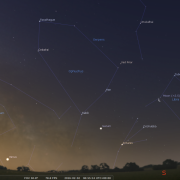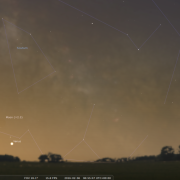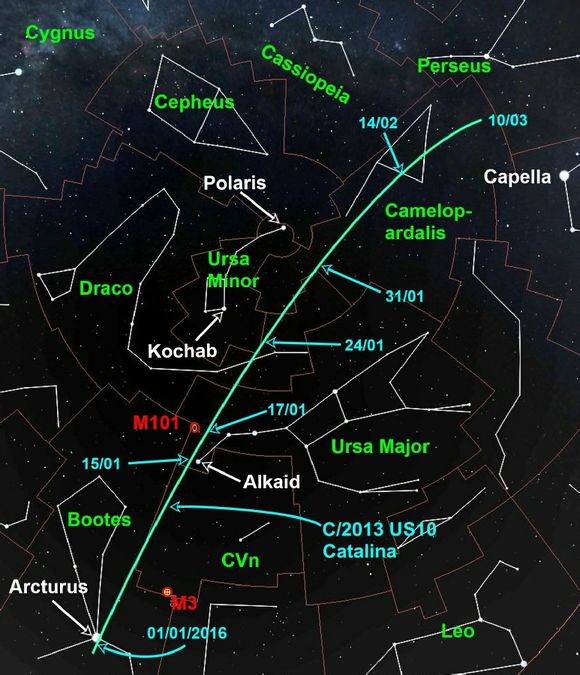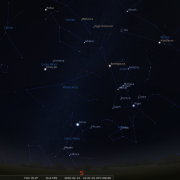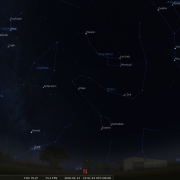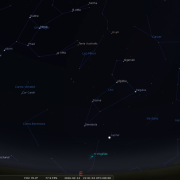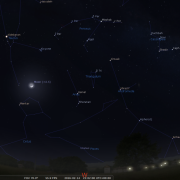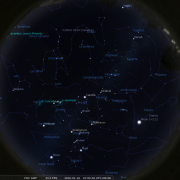In this month's Sky Notes:
Planetary Skylights

 Conspicuous Jupiter will be visible in the east shortly after 7:30pm at the start of the month and over an hour earlier by the end. Observations with a telescope are best carried out post 10pm, yielding terrific views of the Jovian system including the Galilean moons, visible as specks of light nearby. The Moon lies in the vicinity on the 23rd.
Conspicuous Jupiter will be visible in the east shortly after 7:30pm at the start of the month and over an hour earlier by the end. Observations with a telescope are best carried out post 10pm, yielding terrific views of the Jovian system including the Galilean moons, visible as specks of light nearby. The Moon lies in the vicinity on the 23rd.

 Mars and Saturn reside in the dawn sky – located to the south around 6am. Mars will have an obvious orange hue, whereas Saturn, which resides lower left of Mars, will have a pearly white lustre. Both should be quite conspicuous. The Martian disk is still very small when viewed through a telescope with little detail on offer to the average backyard scope. However matters will improve as Mars draws closer over the coming months for a May opposition date.
Mars and Saturn reside in the dawn sky – located to the south around 6am. Mars will have an obvious orange hue, whereas Saturn, which resides lower left of Mars, will have a pearly white lustre. Both should be quite conspicuous. The Martian disk is still very small when viewed through a telescope with little detail on offer to the average backyard scope. However matters will improve as Mars draws closer over the coming months for a May opposition date.
Saturn is a wonderful early morning observing tonic, as long as you have a telescope. If you find you don’t have sufficient time to view on a morning outside;- setting up a scope can be tedious first thing, why not leave your scope set up in a room facing south in readiness. If you view through an opened widow – allow time for the heat to bleed away. Although not ideal, even if you view through double glazing (not at too acute an angle) you will still be pleasantly surprised at the image – and all in comfort. The moon lies between Mars and Saturn on the 2nd.

 Finally, throughout the first week of February, look for brilliant Venus around 7am very low in the southeast. More difficult to spot is Mercury, residing lower left of Venus. Both should fit in a binocular field of view. A very slender moon resides above them on the 6th.
Finally, throughout the first week of February, look for brilliant Venus around 7am very low in the southeast. More difficult to spot is Mercury, residing lower left of Venus. Both should fit in a binocular field of view. A very slender moon resides above them on the 6th.
Comet C/2013 US10 Catalina
The comet, which is a binocular object, (although it might as well be on the far side of the moon for all the good the weather is affording) passes around 8 degrees lower right of the pole star Polaris at the start of February, look for a fuzzy blob anytime throughout the evening or night as the comet will be circumpolar. The comet passed closest to Earth on Jan 17th a safe distance of 108 million km (67 million miles).
Closed Season for Meteor Showers

There are no major meteor showers this month, although sporadic rates will still amount to half a dozen per hour.
January 2016 Sky Charts
Click each image to see a full-size Sky Chart:
|
Looking South
Mid February - 21:00h |
Looking North |
|
Looking East
Mid February - 21:00h |
Looking West
Mid February - 21:00h |
|
|
|
|
Overview
Mid February - 21:00h |
|
Additional Image Credits:
- Planets and Comets where not otherwise mentioned: NASA
- Sky Charts: Stellarium Software
- Finding Catalina: Starry Night Software
- Log in to post comments

